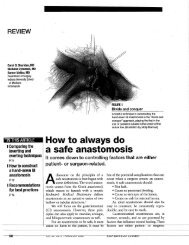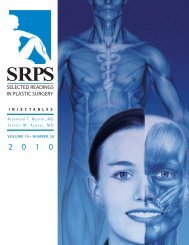SRPS PS - Plastic Surgery Internal
SRPS PS - Plastic Surgery Internal
SRPS PS - Plastic Surgery Internal
You also want an ePaper? Increase the reach of your titles
YUMPU automatically turns print PDFs into web optimized ePapers that Google loves.
<strong>SR<strong>PS</strong></strong> Volume 10, Issue 25, 2009<br />
The treatment of herpetic infections of the hand is<br />
primarily nonsurgical. Rest, elevation, and antiinflammatory<br />
analgesia are the mainstays of<br />
treatment. For immunocompromised patients,<br />
aggressive therapy with intravenously administered<br />
acyclovir might be warranted in an attempt to prevent<br />
a life-threatening viremia. 126,127<br />
Infections in Immunocompromised Patients<br />
Immunocompromised patients can develop hand<br />
infections from opportunistic organisms. The<br />
management of hand infections in<br />
immunocompromised patients is identical, irrespective<br />
of the underlying causes. Many of the fungi, viruses,<br />
and mycobacteria can be cultured only under very<br />
exacting laboratory conditions. Diagnosis almost<br />
certainly requires formal surgical tissue biopsy.<br />
Treatment is dictated by the organism cultured, but<br />
considering that many of the unusual organisms can<br />
take several weeks to grow, therapy must be instituted<br />
“on spec.” If a fungal origin is most likely,<br />
intravenously administered amphotericin B is the first<br />
line treatment. Similarly, for a viral origin, of which<br />
herpes simplex is the most likely, acyclovir is<br />
intravenously administered. Finally, if a mycobacterial<br />
species is suspected, triple-agent therapy (rifampicin,<br />
ethambutol, isoniazid) is instituted.<br />
Diabetes Mellitus<br />
C. albicans infections of the nails are common in<br />
diabetics, so much so that a random blood glucose<br />
level should be obtained as a baseline for any patient<br />
presenting with an infection of the nail complex. The<br />
same has been suggested by some groups for a first<br />
presentation with flexor tenosynovitis. 128 Infections can<br />
commence from relatively simple injuries (e.g., felons<br />
and suppurative flexor tenosynovitis occurring after<br />
fingerstick blood test for glucose levels). 63,129<br />
Microbiology often shows a mixed flora, and S. aureus,<br />
so commonly encountered in “normal” patients with<br />
suppurative hand infections, often is grossly<br />
outweighed by gram-negative organisms. 130 Diabetics<br />
often present with advanced disease (bone, tendon, or<br />
deep space infection), which can also reflect a<br />
peripheral neuropathy as a causative factor. 130–133<br />
Finally, many undergo amputation, either to control<br />
12<br />
infection or because the function in the remaining part<br />
is so poor as to be a hindrance or danger to the patient.<br />
Treatment of hand infections in diabetics must be<br />
early and aggressive if useful function is to be<br />
maintained and amputation avoided. 130–133 Obvious<br />
abscesses must be drained and appropriate specimens<br />
obtained for aerobic and anaerobic cultures.<br />
Radiographs should be obtained and supplemented<br />
with bone scans, if indicated. Broad-spectrum<br />
intravenous antibiotic cover should be instituted and<br />
appropriately modified after cultures are returned.<br />
Rehabilitation should be aggressive and instituted as<br />
soon as the acute manifestations of the infection are on<br />
the wane.<br />
TUMORS<br />
Several authors offer excellent reviews of the spectrum<br />
of hand neoplasms, including their incidence, causes,<br />
anatomic distribution, and management, which almost<br />
always involves surgical remova1. 134–140 Only the more<br />
common hand tumors are discussed herein. The<br />
overwhelming majority of hand masses are benign,<br />
and true neoplasms are rare in the hand (Table 2).<br />
Soft-Tissue Tumors<br />
Ganglia<br />
Ganglia are the most common benign tumors in the<br />
hand. 141–143 Although trauma is commonly thought to be<br />
implicated in the development of ganglia, a traumatic<br />
antecedent has been documented in only a small<br />
percentage of patients. The pathogenesis is thought to<br />
be mucoid degeneration of fibrous connective tissue in<br />
joint capsules or tendon sheaths occurring<br />
idiopathically or secondary to injury or irritation.<br />
Ganglia are two to three times more common in<br />
women than in men. The usual clinical presentation is<br />
that of a mass with or without pain. Occasionally,<br />
occult ganglia present as paresthesias or weakness<br />
from nerve compression. 144–147 Ganglia sometimes even<br />
arise within tendon 148 or bone. 149<br />
Dorsal wrist ganglia—The dorsum of the wrist<br />
accounts for 70% of all ganglia in the hand and wrist.<br />
In the dorsum of the wrist, the ganglion usually<br />
overlies the scapholunate ligament. Clay and Clement 150<br />
noted the pedicle of the ganglion to arise from that site<br />
in 76% of patients. The cause of dorsal wrist ganglia is






